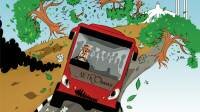Once again the citizenry of Pakistan is abuzz with the news of another mega project that is taking shape in their name… that of the Rawalpindi-Islamabad Bus Rapid Transit scheme. The Government has already held the ground breaking ceremony, while planners and environmentalists are now raising the decibels about its possible negative impacts.
Now no one disputes the fact that big cities need mass transit options to cut the commute, reduce emissions, and generally make the lives of the citizens better.
As things stand, the first option that Pakistan can go for, is the BRT or Bus Rapid Transit because we have seen what has happened to the deliberation that have been going on for decades over the Karachi Circular Railway, to reduce the pressure in the most populous city of Pakistan; a city that is still without a mass transit system.
Lahore has already had the Metro Bus running on a single line and apparently another is being planned. However, the gaping holes in the planning and management of the Lahore Metro bus project are what are exacerbating the fears of citizens who feel that the lessons have not been learnt.
If tested on the objectives of economic benefit, ease of mobility, environment-friendly operations, and benefit to the majority of citizens, the Lahore Metro Bus does not score too high. According to Advocate Rafay Alam, “urban transportation projects should transform the city, make them more livable and safer. The important thing to ask about the Pindi-Islamabad service is will it make the cities better, sustainable, more livable. How will it be designed? What will be the fare; the subsidy (to see if it is economically sustainable - there’s no point spending billions on something that will be a drain on the economy).”
Urban planner and rights activist Imrana Tiwana cautions about the replication of the myopic planning witnessed in Lahore in the Rawalpindi-Islamabad project. She mentions the disregard for the cultural heritage, and the rights of pedestrians, the elderly and the ill to access the bus service because of the flawed design. She also mentions the callous sop that the authorities offered to them by installing a ‘one way’ escalator that takes such persons up, but does not bring them down!
Or the fact that the huge financial outlay that was required for this project was provided by a LOAN from the Turkish government, which will of course be paid for by the tax payers whereas only less than 1% of the population of Lahore benefits from it. And that benefit too comes by way of a huge subsidy that is necessary to keep the ticket price at Rs.20, whereas the market price would have been Rs.200! So it totally fails on the economic feasibility front too.
Imrana Tiwana also points out that the principles of equity, the essential building block of development too were totally flouted as the amount spent to serve a single track in Lahore could have been used to revamp the public transport system in all of the 30 districts of Punjab. The skewed allocation of resources to leave the majority under served is a pattern that defies development goals.
Now on to Pindi and Islamabad, and add to this mix the fact that the planned route is likely to destroy over 10,000 trees from the medians. Now this is the latest buzz about the bus project. In a country where the tree cover is already miniscule, and where the rapidity of depletion beats all other such examples in the world, the mere mention of tree cutting would send any sane person in a spin.
To allay the fears of the ‘Green Lobby’ a bright spark from CDA has said that trees could be replanting in alternate locations, which is a prohibitively expensive option, and not a 100% reliable one. It is not even mentioned in the initial overall plan designed by the CDA. Besides, Islamabad is a planned city, and Imrana says there are comprehensive plans made according to the projections that cover all the development sectors which are not even referred to when new projects and schemes are envisaged.
What is even more worrying is the fact that in the haste to get such large infrastructure projects off the ground, laws are by passed. The 18th Amendment has also thrown an added element of confusion into the mix. The Punjab government, always gung ho for infrastructure development has jurisdiction over the Pindi leg, while CDA will have take Islamabad’s responsibility.
Right now, the voices of caution, especially those fearing environmental degradation, can only be heard from Islamabad, and they center on the threat of denudation of the tree cover. They are also not very convinced about the reduction in emissions.
While it is true that the plying of bigger buses and phasing out of smaller vehicles is likely to have a positive effect on the emissions of exhaust fumes which deteriorate air quality, but the question remains whether the BRTS will generate enough of confidence, and it be such a significant convenience that people who use their personal vehicles, of whom there is a majority, will give them up and hop on to these public buses.
How much of a social change has the Metro Bus brought about it Lahore? Have people stopped using their cars and started to go to their schools, universities, offices in the bus? Has the number of cars on Lahore roads reduced? Has there been a drop in the orders placed for vehicles?
Another very good point made by some environmentalists is that the reduction in emissions cannot come about just by the installation of Euro standard engines in the new buses, when there is no availability of the same standard of fuel. With the country having run itself out of CNG, that option is out of the window as well.
Country Representative of International Union for Conservation of Nature, Mahmood Akhtar Cheema says that if it is viewed in the context of climate change mitigation, there is no denying the fact that mass transit in congested urban cities. For this, BRT, or Bus Rapid Transit is an accepted solution. We have the successful examples of Ahmadabad, Bogota.
However, what is needed that there should be no undue haste in pushing through similar projects as in the absence of a sound feasibility, compromises result. Whatever shortcomings have been assessed in the earlier projects must be eliminated from the newer ones being planned.
IUCN as an organization has been working to mainstream Strategic Environment Assessment of such projects so that the pros and cons can be assessed before starting it. However, it is not yet obligatory, and there is no legislation in place. A task force has been set up with the Planning Commission and while the two projects undertaken are in the field of Hydro and Urban Planning, the learnings have resulted in the Balochistan and Sindh Environment Protection Agency already making it obligatory for projects in their provinces.
While this situation is not there in Punjab or Islamabad Capital Territories, for the proposed BRT project, the law of the land requires an Environment Impact Assessment, on the basis of which an Environment Management Plan has to be formulated. This should be publicly available so the projects’ progress can be monitored by the concerned citizens as well.
As the project stands right now, the ground breaking has already been done, but it still needs to go through the fine toothed process of an EIA, which makes it mandatory for a public hearing to be held. It is hoped that the citizens groups who have their reservations about it, as well as the technical experts will make a show of strength there and ask all the right questions.
If, as has happened so many times before, the Government by passes due process, then at least in the Punjab there are the Green Benches, headed by Justice Mansoor Ali Shah. Islamabad however does not yet have a functioning Environmental Tribunal. Be that as it may, while the Environment Protection Act 1997 is clear in directive for an EIA of a project of this scale, there is always room for recourse to the Courts if the due process is not followed.
It is extremely important to ensure that if this project is to go through, then it should be environmentally sustainable, economically feasible, and socially equitable for the country to really reap its benefits. This means that heed must be paid to those pointing out the lack of forward planning by not making it a CDM (Clean development Mechanism) compliant project.
One must also take another look at the priorities and assess whether such a capital intensive project that is going to benefit a small number of people in these two small cities is even ethically justified when the bigger cities are grappling with bigger problems that are not getting resolved due to lack of attention from development planners.
The writer is a journalist based in Karachi.






















